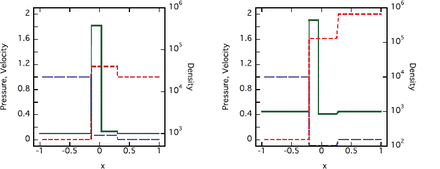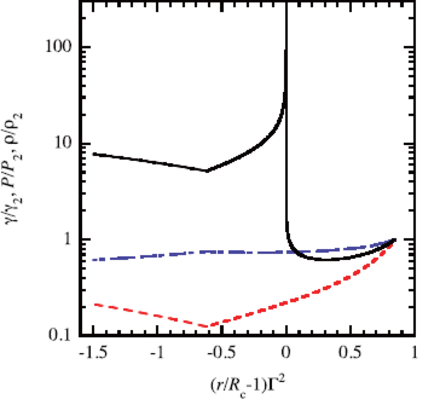-
PDF
- Split View
-
Views
-
Cite
Cite
Toshikazu Shigeyama, Akihiro Suzuki, Ko Nakamura, Early Evolution of Spherical Ejecta Expanding into the Circumstellar Matter at Ultra-Relativistic Speeds, Publications of the Astronomical Society of Japan, Volume 64, Issue 4, 25 August 2012, 87, https://doi.org/10.1093/pasj/64.4.87
Close - Share Icon Share
Abstract
We present a new self-similar solution describing the early evolution of an ultra-relativistic flow resulting from a collision of homologously expanding spherical ejecta with the circumstellar matter, in which a shock wave propagates in the circumstellar matter, while a weak discontinuity propagates in the ejecta at the sound speed.
1. Introduction
Ultra-relativistic flows play important roles in some astrophysical phenomena, like |$ \gamma$|-ray bursts, where fire balls with the Lorentz factors exceeding 100 are thought to drive the phenomena. There are several self-similar solutions involving such ultra-relativistic flows. Blandford and McKee (1976) found self-similar solutions for flows resulting from point explosions in the relativistic limit. Adopting their prescription, Nakayama and Shigeyama (2005) described shock emergence from a plane-parallel atmosphere. Furthermore, Nakamura and Shigeyama (2006) found relativistic version of the spherical flow relevant to young supernova remnants in which ejecta interact with the circumstellar matter (CSM) through two shock waves and the contact surface in between. Here, we present a new self-similar solution describing flows associated with ejecta expanding into the CSM in a somewhat different manner. A shock wave propagating in the CSM leads the jet, and forms a dense shell while detaching itself from the homologously expanding ejecta. The inner wave front is a rarefaction wave propagating into the ejecta. This phase follows the spreading phase where the dense shell expands almost freely (Mészáros & Rees 1993), and precedes the phase described by Nakamura and Shigeyama (2006).
A similar flow has been observed in 2-D axisymmetric simulations for jets driven by aspherical supernova explosions (Nagakura et al. 2011, Suzuki & Shigeyama 2011), though detailed analyses of the structure of the jet in the radial direction are prohibited by coarse grids to cover the large dynamic range. It is expected from the same calculation that the propagation of the ultra-relativistic jet in the vicinity of the axis of symmetry is well approximated by the corresponding flow, assuming spherical symmetry, because the fluxes of the mass, momentum, and energy as well as the pressure gradient in the lateral direction are too small to affect the structure and propagation of the jet. Therefore, a spherically symmetric solution presented in this paper will be useful to investigate the radial structure of jets near the axis of symmetry.
In the next section, we discuss the initial conditions needed to realize the flow described by the self-similar solution presented in this paper. In section 3, we present the basic equations governing the ultra-relativistic flows in spherical symmetry. In section 4, we describe the density and pressure distributions of the ejecta. In section 5, we formulate the flow propagating in the ejecta using a prescription similar to that presented in Nakamura and Shigeyama (2006). In section 6, we discuss the propagation of the shock in the CSM using the self-similar solution found by Blandford and McKee (1976). The boundary conditions at the contact surface are given in section 7. Section 8 presents the results. In section 9, we conclude the paper.
2. Initial Conditions
Here, the velocity is measured in units of the speed of light, |$ c$|.
To validate this condition, we solved the shock tube problems with parameters satisfying and not satisfying the above condition, and present the results in figure 1. In the left panel, two fluids with the density |$ \rho$| |$ =$| 10|$ ^3$| are in contact at the position |$ x$| |$ =$| 0 at time |$ t$| |$ =$| 0. The fluid in the region |$ x$| |$ \lt$| 0 having the pressure |$ P$| |$ =$| 1 moves in the positive |$ x$| direction with the Lorentz factor |$ \gamma_{\rm e}$| |$ =$| 100, while the fluid in the region |$ x$| |$ \ge$| 0 is at rest, and has a pressure |$ P$| |$ =$| 10|$ ^{7}$| . Therefore, these satisfy the above condition (2) for two shock waves, and the resultant flow in the figure at |$ t$| |$ =$| 0.5 actually shows two shock waves. Here, the plotted pressure is scaled by a factor of 10|$ ^{-7}$| and the velocity is measured in units of the speed of light. If the pressure in the right fluid is enhanced by a factor of two, the initial configuration does not satisfy the condition for two shock waves, but results in the flow pattern presented in the right panel at |$ t$| |$ =$| 0.5. However, it should be noted here that criterion (2) does not accurately define the boundary of these two flow patterns, and should be regarded as an approximate guide line to guess the resulting flow pattern from the initial conditions.

Solutions for a relativistic shock tube problem with two different sets of initial conditions. The distributions of pressure (dashed line), velocity (dash-dotted line), and density (solid line) at time |$ t$| |$ =$| 0.5 are shown. The initial conditions at |$ t$| |$ =$| 0 are as follows. The density is equal to 10|$ ^3$|. The fluid in the region with |$ x$| |$ \lt$| 0 moves with the Lorentz factor 100 in the positive |$ x$| direction, and has a pressure equal to 1. The pressure in |$ x$| |$ \ge$| 0 is 10|$ ^7$| in the left panel, while 2 |$ \times$| 10|$ ^7$| in the right panel. The pressure is scaled by a factor of 10|$ ^{-7}$|.
3. Ultra-Relativistic Flow
Here, |$ r$| and |$ t$| denote the radial and time coordinates. The Lagrange derivative is described by |$ d/dt$| . The pressure is denoted by |$ P$| and the ultra-relativistic equation of state |$ \epsilon$| |$ =$| 3|$ P/\rho$| |$ \gg$| 1 has been assumed. The mass density in the fixed frame is denoted by |$ \rho^\prime$| , which is related to the mass density, |$ \rho$| , in the co-moving frame as |$ \rho^\prime$| |$ =$| |$ \gamma\rho$| , where |$ \gamma$| is the Lorentz factor of the fluid element.
In constructing the self-similar solution, we follow the procedure of Nakamura and Shigeyama (2006), but with different inner boundary conditions.
4. Homologous Ejecta
In Nakamura and Shigeyama (2006), the pressure in the homologous ejecta was neglected because a strong shock wave propagates in the ejecta. In this paper, a rarefaction wave is assumed to propagate in the ejecta, and we need to specify the pressure distribution.
5. Rarefaction Wave
Thus, the parameter |$ m$| is evaluated as |$ m$| |$ =$| 1|$ /\sqrt{3}$|.
6. Flow in the Shocked Circumstellar Matter
Finally, we will present equations governing the self-similar flow in the shocked CSM and the associated boundary conditions. These are identical to those in Blandford and McKee (1976).
6.1. Shock Conditions in the CSM
6.2. Self-Similar Flow
Because |$ m$| |$ =$| 1|$ /\sqrt{3}$| , the similarity solution is uniquely determined by specifying the parameter |$ k$|.
7. The Flow at the Contact Surface
The former equation indicates that the density in the CSM diverges if 1|$ /\sqrt{3}$| |$ \lt$| |$ k$| |$ \lt$| 4 |$-$| |$ \sqrt{3}/$| 9; otherwise, the density in the CSM becomes zero at the contact surface. From the latter equation, when |$ k$| |$ =$| 0, i.e., the CSM has a uniform density, the density in the ejecta diverges at the contact surface if |$ n$| |$ \lt$| 6|$ \sqrt{3}$| |$-$| 3|$ /$| 2. When |$ k$| |$ =$| 2, i.e., the CSM is formed by a stationary stellar wind, the density in the ejecta diverges at the contact surface if |$ n$| |$ \lt$| 3|$ \sqrt{3}$| |$-$| 3|$ /$|2.

Distributions of the Lorentz factor (dash-dotted line), density (solid line), and pressure (dashed line) normalized with those values at the shock front as functions of scaled distance from the contact surface. The parameters are |$ n$| |$ =$| 2, |$ k$| |$ =$| 2, |$ l$| |$ =$| 2 |$-$| 7|$ \sqrt{3}/9$|.
8. Results
Results with a combination of parameters |$ n$| |$ =$| |$ k$| |$ =$| 2 are presented in figure 2. The other parameters are as follows: |$ a$| |$ =$| 10|$ ^{6}$| , |$ b$| |$ =$| 5.02 |$ \times$| 10|$ ^{11}$| , |$ K_{0}$| |$ =$| 5.43 |$ \times$| 10|$ ^{22}$| , and |$ t_{0}$| |$ =$| 10|$ ^{4}$| in cgs units. These values are obtained from ejecta having a Lorentz factor of 300, a temperature of 10|$ ^{6}$| K, and a density of 10|$ ^{-10}$| g cm|$ ^{-3}$| at the front. The ejecta collide at |$ r$| |$ =$| |$ ct_{0}$| with the stationary wind with a mass loss rate of 10|$ ^{-5}\ M_{\odot}$| yr|$ ^{-1}$| . The wind velocity is assumed to be 1 |$ \times$| 10|$ ^{8}$| cm s|$ ^{-1}$| . The plotted pressure, Lorentz factor, and density are normalized by those values at the shock front in the CSM. Note that the density profile on the left side of the contact surface in this plot changes with time, while the other profiles remain unchanged with time.
9. Conclusions and Discussion
We have presented a new self-similar solution describing the early phase of collisions between spherical ejecta expanding at ultra-relativistic speeds and the CSM. The flow is characterized by the forward shock propagating in the CSM, the contact surface, and the rarefaction front with a weak discontinuity propagating in the ejecta. As the forward shock proceeds in the CSM, a reverse shock eventually forms. Then, another self-similar solution by Nakamura and Shigeyama (2006) appropriately describes the flow afterwards. Though these solutions assume spherical symmetry, they can be used to describe flows of relativistic jets in the vicinity of the axis of symmetry, since the 2-D numerical simulations show that the flux in the transverse direction is negligible there.
If the actual pressure distribution deviates from this, and becomes shallower, then the transition is expected to occur. The transition indicates a change in the time dependence in the shock Lorentz factor. It will be intriguing to investigate the influences of this change on the emission in connection with light-curve features of some |$ \gamma$|-ray bursts. For example, GRB 110205A exhibits a steep rise in its optical light curve, starting at a few hundred seconds after detection, while the X-ray light curve shows a small bump around the same period (Zheng et al. 2012). This might be related to the transition taking place at |$ r$| |$ \sim$| 10|$ ^{18}$| cm from the explosion site and associated deceleration of the shock front, though calculations of the emission from such a shocked relativistic matter is beyond the scope of the present paper.
References



